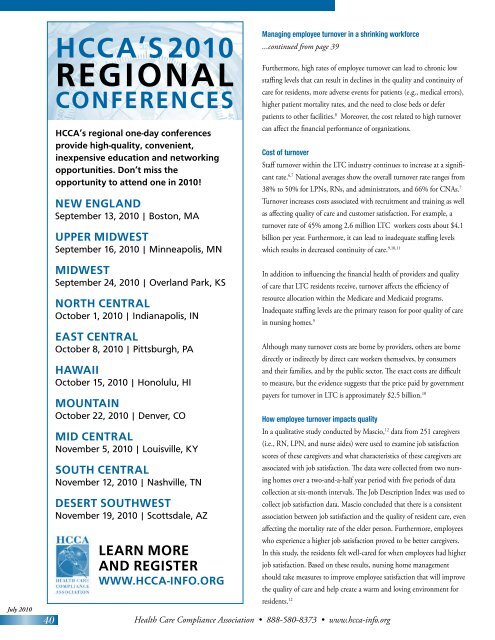Kimberly Johnson, RHIA, CPC, CHC - Health Care Compliance ...
Kimberly Johnson, RHIA, CPC, CHC - Health Care Compliance ...
Kimberly Johnson, RHIA, CPC, CHC - Health Care Compliance ...
You also want an ePaper? Increase the reach of your titles
YUMPU automatically turns print PDFs into web optimized ePapers that Google loves.
HCCA’s 2010<br />
RegionAl<br />
ConfeRenCes<br />
HCCA’s regional one‐day conferences<br />
provide high‐quality, convenient,<br />
inexpensive education and networking<br />
opportunities. don’t miss the<br />
opportunity to attend one in 2010!<br />
new englAnd<br />
September 13, 2010 | Boston, MA<br />
UppeR Midwest<br />
September 16, 2010 | Minneapolis, MN<br />
Managing employee turnover in a shrinking workforce<br />
...continued from page 39<br />
Furthermore, high rates of employee turnover can lead to chronic low<br />
staffing levels that can result in declines in the quality and continuity of<br />
care for residents, more adverse events for patients (e.g., medical errors),<br />
higher patient mortality rates, and the need to close beds or defer<br />
patients to other facilities. 8 Moreover, the cost related to high turnover<br />
can affect the financial performance of organizations.<br />
Cost of turnover<br />
Staff turnover within the LTC industry continues to increase at a significant<br />
rate. 6,7 National averages show the overall turnover rate ranges from<br />
38% to 50% for LPNs, RNs, and administrators, and 66% for CNAs. 7<br />
Turnover increases costs associated with recruitment and training as well<br />
as affecting quality of care and customer satisfaction. For example, a<br />
turnover rate of 45% among 2.6 million LTC workers costs about $4.1<br />
billion per year. Furthermore, it can lead to inadequate staffing levels<br />
which results in decreased continuity of care. 9,10,11<br />
July 2010<br />
40<br />
Midwest<br />
September 24, 2010 | Overland Park, KS<br />
noRtH CentRAl<br />
October 1, 2010 | Indianapolis, IN<br />
eAst CentRAl<br />
October 8, 2010 | Pittsburgh, PA<br />
HAwAii<br />
October 15, 2010 | Honolulu, HI<br />
MoUntAin<br />
October 22, 2010 | Denver, CO<br />
Mid CentRAl<br />
November 5, 2010 | Louisville, KY<br />
soUtH CentRAl<br />
November 12, 2010 | Nashville, TN<br />
deseRt soUtHwest<br />
November 19, 2010 | Scottsdale, AZ<br />
leARn MoRe<br />
And RegisteR<br />
www.HCCA‐info.oRg<br />
In addition to influencing the financial health of providers and quality<br />
of care that LTC residents receive, turnover affects the efficiency of<br />
resource allocation within the Medicare and Medicaid programs.<br />
Inadequate staffing levels are the primary reason for poor quality of care<br />
in nursing homes. 9<br />
Although many turnover costs are borne by providers, others are borne<br />
directly or indirectly by direct care workers themselves, by consumers<br />
and their families, and by the public sector. The exact costs are difficult<br />
to measure, but the evidence suggests that the price paid by government<br />
payers for turnover in LTC is approximately $2.5 billion. 10<br />
How employee turnover impacts quality<br />
In a qualitative study conducted by Mascio, 12 data from 251 caregivers<br />
(i.e., RN, LPN, and nurse aides) were used to examine job satisfaction<br />
scores of these caregivers and what characteristics of these caregivers are<br />
associated with job satisfaction. The data were collected from two nursing<br />
homes over a two-and-a-half year period with five periods of data<br />
collection at six-month intervals. The Job Description Index was used to<br />
collect job satisfaction data. Mascio concluded that there is a consistent<br />
association between job satisfaction and the quality of resident care, even<br />
affecting the mortality rate of the elder person. Furthermore, employees<br />
who experience a higher job satisfaction proved to be better caregivers.<br />
In this study, the residents felt well-cared for when employees had higher<br />
job satisfaction. Based on these results, nursing home management<br />
should take measures to improve employee satisfaction that will improve<br />
the quality of care and help create a warm and loving environment for<br />
residents. 12<br />
<strong>Health</strong> <strong>Care</strong> <strong>Compliance</strong> Association • 888-580-8373 • www.hcca-info.org

















